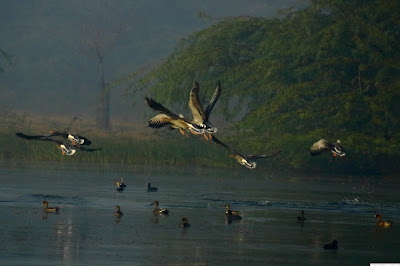Some of the best photographs of birds in flight are taken early in the morning and my preferable ISO setting is between 100 and 400. In most cases, a shutter speed of 640/1 should work preferable well. Although I carry a monopod or a tripod most of the time, I, however, rarely use them as they restrict free movement.
Greylag Geese and Painted Storks are some of the larger birds that can be shot easily in flight, taking off or alighting. If you are subtle enough and careful about hiding yourself from the birds, you might get close enough to them to use a 70-300 mm zoom lens. I find the USM lens handy enough for wildlife photography.
Some of the larger animals like Antelopes can be photographed using a slower shutter speed, again if you are still enough and properly camouflaged. Wearing clothes in muted colours helps a lot. This is why the clothes you wear is as important as the camera equipment you carry. Although I wear spectacles generally, I avoid wearing them on wildlife shoots. Any glint from the lenses of your glasses can frighten away wildlife. I like shooting in the raw and aim for slightly underexposed photographs so that the colours come out really nicely!
One very important tip for all wildlife photography enthusiasts is to reach the venue early in the morning, preferably before all the others appear. My go-to place happens to be the Sultanpur National Park in Gurgaon, or the nearby wetlands, especially the Basai Wetland. I prefer reaching the spot by seven in the morning even when it is foggy. Fog, ironically, makes the animals and birds lethargic and thus easier to photograph. The fog also helps conceal the photographer from the animals and birds. This brings me to the question of photographing birds in flight. A reasonably fast shutter speed coupled with the right angle can help greatly. The photographs below are those of Painted Storks landing on the ground to collect sticks and twigs to build up their nests. They have come up reasonable nicely because of the angle of the camera and the direction of the sun.








You're so right, getting pics of animals requires so much patience.
ReplyDeleteThank you so much Matheikal Sir!
Delete